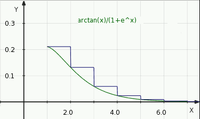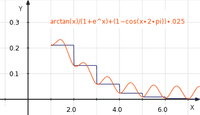We all know that [MATH]\sum_{k=1}^{\infty} \frac{1}{k}[/MATH] diverges. One way to prove that by using the integral test.
This means, since the integral [MATH]\int_1^{\infty} \frac{1}{x} \ dx[/MATH] diverges, the sum is also diverges.
My question is what about the reverse? If the sum is converges, for example, does it mean the integral is also converges?
I am talking about a positive continuously decreasing function such as
[MATH]f(x) = \frac{\tan^{-1} x}{1 + e^x}, x \geq 1[/MATH]
Does this integral converge?
[MATH]\int_0^{\infty} \frac{\tan^{-1} x}{1 + e^x} \ dx[/MATH]
Can I say since [MATH]\sum_{k=0}^{\infty} \frac{\tan^{-1} k}{1 + e^k}[/MATH] converges, then the integral is also converges?
This means, since the integral [MATH]\int_1^{\infty} \frac{1}{x} \ dx[/MATH] diverges, the sum is also diverges.
My question is what about the reverse? If the sum is converges, for example, does it mean the integral is also converges?
I am talking about a positive continuously decreasing function such as
[MATH]f(x) = \frac{\tan^{-1} x}{1 + e^x}, x \geq 1[/MATH]
Does this integral converge?
[MATH]\int_0^{\infty} \frac{\tan^{-1} x}{1 + e^x} \ dx[/MATH]
Can I say since [MATH]\sum_{k=0}^{\infty} \frac{\tan^{-1} k}{1 + e^k}[/MATH] converges, then the integral is also converges?




